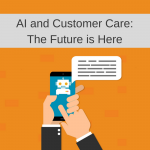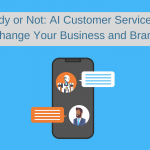The Evolution of Self-Serve Customer Service

Ever have one of those days when you simply don’t want to talk to anyone? That day inevitably coincides with the renewed urgency of the task you’ve been procrastinating over: calling customer service to fix your computer/check your warranty/renew your membership/reset your password.
We know you hate calling tech support. We know you’d rather not “press one for yes.” We certainly get the irritation of being left on hold forever. And so it’s unsurprising that we’ve seen a growing popularity in self-serve customer service. Variations include Tier 0, IVR, automation, and artificial intelligence, and they all have one thing in common: you no longer have to interact with a real live human being. It’s not a new concept, but it has evolved over the years.
If you’re looking to outsource your call center, self-serve at some level will likely be part of your solution design. Tier 0 support has the potential to significantly reduce transactional call volume, while simultaneously engaging your customers on their own terms. However, automation in customer service also carries the risk of negatively impacting the customer experience. Finding a sweet spot is vital.
What Self-Serve Used to Look Like
Assuming you’ve already cut the cord with the few companies that never upgraded from the earliest forms of self-serve customer service (aka “IVR Hell”), we probably don’t have to remind you what Tier 0 support looked like “back in the day.” It’s that circular, primitive version of self-help where you get stuck in an automated loop of endless numeric options and voicemail boxes. Good luck finding what you need.
Companies that implemented the earliest versions of Tier 0 technology were likely excited by the possibilities. It was cutting edge. It relieved agent bandwidth. Their customers hold times were reduced. Most of all, it drove down call volume, resulting in lower call center costs.
But being lowering costs came with a different price: customer frustration and compromised customer loyalty.
What Tier 0 Support Looks Like Today
Today’s self-serve or Tier 0 customer service is heavily focused on customer satisfaction, and as a result, the technology has become increasingly elegant, better integrated, and – most importantly – more user-friendly.
Self-serve is an integral part of omni-channel customer service, seamlessly integrating with the customer experience across social media, live chat, email and phone. Every transaction is captured and stored so that when a customer does eventually interact with a live agent, the agent understands the customer journey and what steps they’ve already taken towards reaching resolution.
Building the right Tier 0 strategy requires a lot of collaboration with your frontline agents as well as a comprehensive understanding of your brand and its promises. It’s not a simple matter of bringing in programmers and saying, “automate this function.” Your customer care team members, including frontline agents, are critical resources in helping to decide how and what to automate. They’ll know which kind of processes and queries can be easily and effectively translated into self-serve customer service. And they’ll know how to communicate it all in a way that aligns with your company’s brand.
It’s also worth mentioning here that engaging a self-serve option or triggering Tier 0 is rarely the first step in the customer journey map. A great self-serve strategy is acutely aware of everywhere a customer may go first before picking up the phone. This includes both online customer support and crowd-sourced customer support. Think of your iPhone or iMac for a moment. Although Apple has a wealth of customer support channels, many people will turn to public forums before they go to Apple’s website, store or phoneline. Being aware of the reasons why people might turn to crowd-sourced customer support is essential in building a strong self-serve strategy.
How Self-Serve Fits into the Customer Experience
We’ve already mentioned the companies that went with the primitive self-serve customer service automation when it was shiny and new. They wanted cost-effectiveness and excitement, and many of them implemented it on every level. On the flip side, though, are companies that go kicking and screaming to Tier 0. Their core belief is that they want 100% agent interaction for every query. But this is equally detrimental to the customer experience.
Sure, your 87-year old grandmother probably wants nothing to do with self-serve. But according to IBM, 75% of Millennials want to solve their own issue. As an ever-growing portion of your customer demographics, supporting the specific preferences of this generation of consumers is vital. When they have a problem with their computer/car/password/membership, they will almost always go to Google first. From there, they will turn to social media, FAQs, public forums, and live chat before they pick up the phone. If you can pleasantly surprise them with a simple, elegant self-serve option via phone (or better yet text or chatbot) that solves relatively simple problems, then you’ve just gained a notch in their level of loyalty (which, as studies show, is fragile and difficult to gain in Millennials in the first place).
Interestingly, although the Millennial generation prefers less human interaction in their customer service, they do value personalized support. That’s where Tier 0 support – and strategic omni-channel service in general – has upped the ante. The proliferation of data that floods into the call center from every channel helps to build a very specific profile of each customer, which enables an agent to personalize their interaction and deliver a differentiated customer experience.
Leveraging Self-Serve Customer Support in Your Call Center
The beauty of an intelligent self-serve solution is that you can redirect your agent efforts to much more complex customer service situations. The auto club member who is experiencing an emergency wants human support not a chatbot. The network administrator who’s troubleshooting a critical issue that impacts enterprise stakeholders needs a partner in the process to make the right decisions and take the right actions quickly. The caller who’s genuinely befuddled by the fine print on their insurance contract wants less frustration and more clarity. These are scenarios where frontline agents are the star of the show. Putting your resources here – instead of the password resets, the membership activations, the billing transactions – benefits both your customer and your bottom line.
We’d love to provide more insight into how Tier 0/self-serve customer service fits into the big picture in your contact center. Let’s chat.



